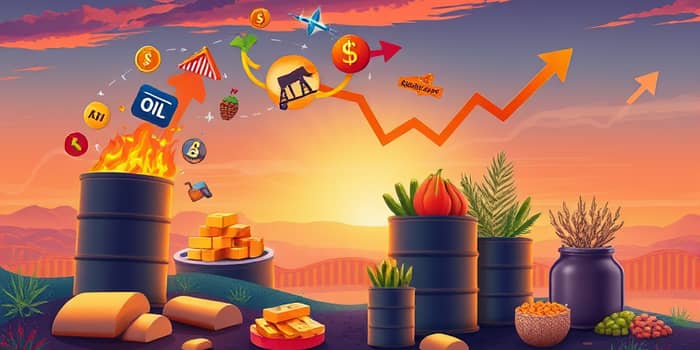
The landscape of global investing has shifted dramatically since the inflation shock of 2022. As prices soared across goods and services, commodities emerged as a beacon for investors seeking stability and returns. Today, with US inflation lingering around 2.9% for headline CPI and 3.2% for core CPI—well above the Federal Reserve’s 2% target—allocations to commodity strategies continue to captivate market participants.
Understanding why this asset class remains compelling requires examining recent history, current drivers, sector dynamics, and actionable strategies. By weaving data with real-world context, investors can harness insights to construct portfolios that thrive amid volatility.
Back in 2022, the Bloomberg Commodity Index surged over 16%, while traditional stocks and bonds experienced sharp losses. This divergence highlighted commodities’ unique role as a diversification tool. As inflation peaked and then gradually softened, equities rebounded, yet commodities delivered only modest gains.
Fast forward to late 2024 and early 2025, and US consumers still feel price pressures. The persistence of elevated inflation has kept allocations toward raw materials in the spotlight, a trend driven by both sentiment and the search for yield.
Commodity inflows are underpinned by several key drivers:
This confluence of factors has sustained interest in commodity funds, ETFs, and direct futures positions despite a generally muted price outlook.
Commodities are not monolithic. Sector-level trends reveal differentiated opportunities and risks:
Energy markets, led by oil and natural gas, remain sensitive to geopolitical developments. The World Bank forecasts overall commodity prices to fall roughly 12% in 2025 and another 5% in 2026, driven largely by easing energy tightness. However, any supply cut by OPEC+ or renewed tension in key producing regions could reverse declines.
Industrial metals face headwinds from China’s economic slowdown, even as global infrastructure plans and green-energy spending offer support. Gold, meanwhile, contends with higher real rates and dollar strength but could regain appeal if central banks pivot to easier policies.
Agriculture exhibits its own volatility. Grain prices fluctuate with weather and geopolitical disruptions, while produce subcategories show varied trajectories. For example, fresh vegetable prices are forecast to drop 2.5% in 2025, even as poultry and sugar see modest gains.
To navigate this environment, consider these practical approaches:
While broad commodity prices may trend downward amidst weaker global growth, investors must prepare for geopolitical tensions or severe weather events that can trigger unexpected inflows and rapid price spikes. Conversely, a deeper economic slowdown or stronger dollar could press commodity valuations lower.
The decade-long rise in price volatility underscores the need for vigilance. As supply chains recalibrate post-pandemic and climate-related disruptions intensify, the commodity landscape will remain dynamic. Those who adopt a proactive stance stand to gain not only protection but also potential alpha.
Commodities play a dual role: they can shield against erosion of purchasing power and capture upside during market shocks. By integrating raw materials alongside traditional assets, investors enhance diversification and explore new return streams.
Implementing a disciplined framework—setting clear allocation targets, reviewing exposures regularly, and adjusting to evolving fundamentals—ensures that commodity strategies fulfill their promise rather than becoming speculative wagers.
Amid lingering inflation concerns, commodity inflows are more than a fleeting trend. They represent a strategic shift toward embracing tangible assets that resonate with the economic realities of today and tomorrow. By combining historical perspective, sector-level intelligence, and robust risk management, investors can transform uncertainty into opportunity.
As you refine your portfolio for 2025, remember that the true power of commodities lies not just in price movements, but in their capacity to anchor diversified portfolios against the rising tide of inflation and volatility.
References













